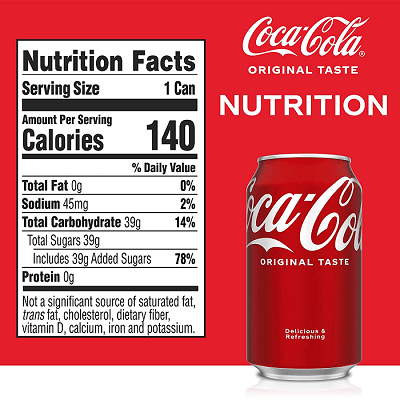Discover the secrets behind Coca Cola’s ingredients. Uncover the mystery surrounding the closely guarded formula of this iconic beverage. Learn about the key ingredients and their role in creating the distinct flavor of Coca Cola. Explore the history and tradition behind Coca Cola’s recipe, and gain insights into the brand’s commitment to quality and taste. Everything you need to know about Coca Cola’s ingredients awaits.
What is Coca Cola
Coca Cola is known for its distinct flavor and effervescence. It is made from a combination of carbonated water, sweeteners (such as high fructose corn syrup or sucrose), natural flavors (including caffeine), caramel color, phosphoric acid, and other ingredients.
The Coca Cola Company, headquartered in Atlanta, is the producer and marketer of Coca Cola. The company offers a range of Coca Cola products, including regular Coca Cola, Coca Cola Zero Sugar, Diet Coke, and various flavored variations.
Coca Cola is sold in bottles, cans, and fountain drink dispensers in numerous countries around the world. It has become an iconic symbol of the global beverage industry and is enjoyed by millions of people worldwide.
What is Coca Cola Ingredients
- Carbonated Water: Water that has been infused with carbon dioxide gas to create the characteristic fizziness.
- High Fructose Corn Syrup: A sweetener commonly used in many soft drinks, including Coca Cola. In some countries, sucrose (table sugar) may be used instead.
- Caramel Color: A food coloring agent that gives Coca Cola its distinctive brown color.
- Phosphoric Acid: An acidic compound used for flavoring and as a preservative.
- Natural Flavors: Coca Cola contains a combination of natural flavors, which contribute to its taste. The specific flavors and their sources are not disclosed publicly.
- Caffeine: A natural stimulant found in Coca Cola. The amount of caffeine may vary depending on the specific product and country.
- Phosphoric Acid: It is used as a preservative and for adding a tart flavor to the beverage.
- Preservatives: Coca Cola may contain preservatives to help extend its shelf life.
Facts about Coca Cola Ingredients
Original Recipe: The original Coca Cola recipe, known as “Merchandise 7X,” includes a combination of ingredients such as carbonated water, high fructose corn syrup (or sucrose in some countries), caramel color, phosphoric acid, natural flavors (including caffeine), and preservatives.
Secret Formula: The exact formula for Coca Cola, including the specific amounts and proportions of ingredients, is a closely guarded trade secret. Only a few employees are privy to the complete recipe, and it is locked away in a vault in Atlanta, Georgia.
Caffeine: Coca Cola contains caffeine, which is a natural stimulant. The amount of caffeine in a can or bottle of Coca Cola can vary based on the specific product and the country in which it is sold.
Sweeteners: While high fructose corn syrup is commonly used as a sweetener in Coca Cola, some versions of the beverage use sucrose (table sugar) instead. The choice of sweetener may vary depending on regional preferences and regulations.
Natural and Artificial Flavors: Coca Cola utilizes a combination of natural and artificial flavors to achieve its distinctive taste. The specific flavors and their sources are not publicly disclosed.
Carbonation: Carbonated water is an essential ingredient in Coca Cola, contributing to its characteristic fizziness.
Coloring: Caramel color is used to give Coca Cola its iconic brown hue. It is a common food coloring agent used in various beverages and foods.
Preservatives: Phosphoric acid is added to Coca Cola as a preservative, helping to prolong its shelf life.
Benefits of Coca Cola Ingredients
- Taste and Refreshment: Coca Cola’s combination of flavors, carbonation, and sweetness provides a unique taste experience that many people find enjoyable and refreshing.
- Variety: Coca Cola offers a range of products with different flavors and variations, allowing consumers to choose according to their preferences.
- Brand Recognition and Tradition: Coca Cola has a long-standing history and is a globally recognized brand. Its presence is often associated with social occasions, celebrations, and nostalgia.
- Versatility: Coca Cola can be consumed on its own or used as a mixer for various cocktails and beverages, adding to its versatility.
- Enjoyment and Indulgence: Coca Cola is often associated with moments of relaxation, entertainment, and pleasure, providing a sense of enjoyment and indulgence.
Why is high fructose corn syrup used in Coca Cola?
High fructose corn syrup is commonly used as a sweetener in Coca Cola due to its affordability and availability. In some countries, Coca Cola may use sucrose (table sugar) instead.
Are the ingredients in Coca Cola harmful?
Coca Cola and its ingredients, when consumed in moderation as part of a balanced diet, are generally considered safe. However, excessive consumption of sugary beverages may contribute to health issues like obesity and dental problems.
Are there any vegetarian or vegan versions of Coca Cola?
The ingredients in Coca Cola are typically considered vegetarian. However, it’s important to note that the specific ingredients used may vary by region, so it’s advisable to check the product label or contact Coca Cola directly for the most accurate information.
Does Coca Cola Contain any Allergens?
Coca Cola does not contain any common allergens like milk, eggs, fish, shellfish, tree nuts, peanuts, wheat, or soy. However, individuals with specific allergies should always check the product labels for potential cross-contamination or contact Coca Cola for more information.
Merchandise 7X
The secret behind Coca Cola lies in its closely guarded formula known as “Merchandise 7X.” The exact recipe and proportions of ingredients are kept as a trade secret, known only to a select few individuals within The Coca Cola Company. The secrecy surrounding the formula has been maintained for over a century, creating an air of mystery and intrigue.
The formula for Coca Cola was developed by pharmacist John Stith Pemberton in the late 19th century. It is said to contain a combination of ingredients including carbonated water, sweeteners, caramel color, natural flavors (including caffeine), phosphoric acid, and preservatives. However, the specific amounts and details of the ingredients remain undisclosed.
The secret formula is highly protected and stored in a vault at The Coca Cola Company’s headquarters in Atlanta, Georgia. Only a handful of individuals have access to this information. The company takes extensive measures to ensure the formula’s secrecy, including security systems and non-disclosure agreements.
The secrecy surrounding the formula is a key aspect of Coca Cola’s branding and marketing strategy. It adds to the allure and mystique of the brand, creating a sense of exclusivity and uniqueness.
Despite many attempts to replicate the taste of Coca Cola, the precise flavor remains distinct and recognizable worldwide. The secrecy of the formula has played a significant role in the enduring success and iconic status of Coca Cola as a beverage brand.
Coca Cola Flavour & Taste
- Coca Cola Classic: The original and iconic flavor of Coca Cola, known for its unique blend of sweetness, acidity, and carbonation.
- Coca Cola Zero Sugar: A sugar-free version of Coca Cola that aims to provide the taste of Coca Cola Classic without the added sugar.
- Diet Coke: A low-calorie version of Coca Cola that offers a different taste profile with its own distinct flavor.
- Coca Cola Cherry: Coca Cola with a hint of cherry flavor added for a fruity twist.
- Coca Cola Vanilla: Coca Cola with the addition of vanilla flavoring, providing a smooth and creamy taste.
- Coca Cola Lime: Coca Cola infused with a refreshing hint of lime flavor.
- Coca Cola Orange: Coca Cola with a burst of orange flavor for a citrusy twist.
- Coca Cola Raspberry: Coca Cola with the addition of raspberry flavor, creating a fruity and sweet taste.
- Coca Cola Energy: A caffeinated beverage that combines the taste of Coca Cola with additional energy-boosting ingredients.
- Coca Cola Life: A reduced-calorie cola sweetened with a blend of cane sugar and stevia leaf extract.
The Truth Behind Coca Cola bottle
The Contour Bottle was designed to be easily recognizable even in the dark or when broken. Its unique silhouette has become synonymous with Coca Cola and has contributed to the brand’s visual identity.
Over the years, the Coca Cola bottle has undergone slight modifications, but the overall shape and essence have remained consistent. The glass bottle was initially the primary packaging for Coca Cola, but the brand has also introduced plastic bottles and cans to cater to evolving consumer preferences and convenience.
The Coca Cola bottle has become a collectible item, with special editions and limited-edition designs released to commemorate events, anniversaries, and collaborations. It is a symbol of nostalgia, refreshment, and enjoyment associated with the brand.
The Coca Cola bottle has transcended its functional purpose and has become an iconic design recognized worldwide. It represents the enduring appeal and timeless nature of the Coca Cola brand.
In conclusion, Coca Cola’s ingredients are an essential part of its identity and flavor. While the exact recipe remains a closely guarded secret, we have explored the known elements, including carbonated water, sweeteners, caramel color, natural flavors, phosphoric acid, and preservatives. The specific combination and proportions of these ingredients create the unique taste experience that Coca Cola is famous for. Despite the intrigue surrounding its formula, Coca Cola continues to captivate consumers worldwide with its refreshing and iconic flavor. Whether enjoyed on its own or mixed with other beverages, Coca Cola’s ingredients contribute to its enduring popularity and status as a beloved global brand.
Keep Learning>>> Scholarships Finder







